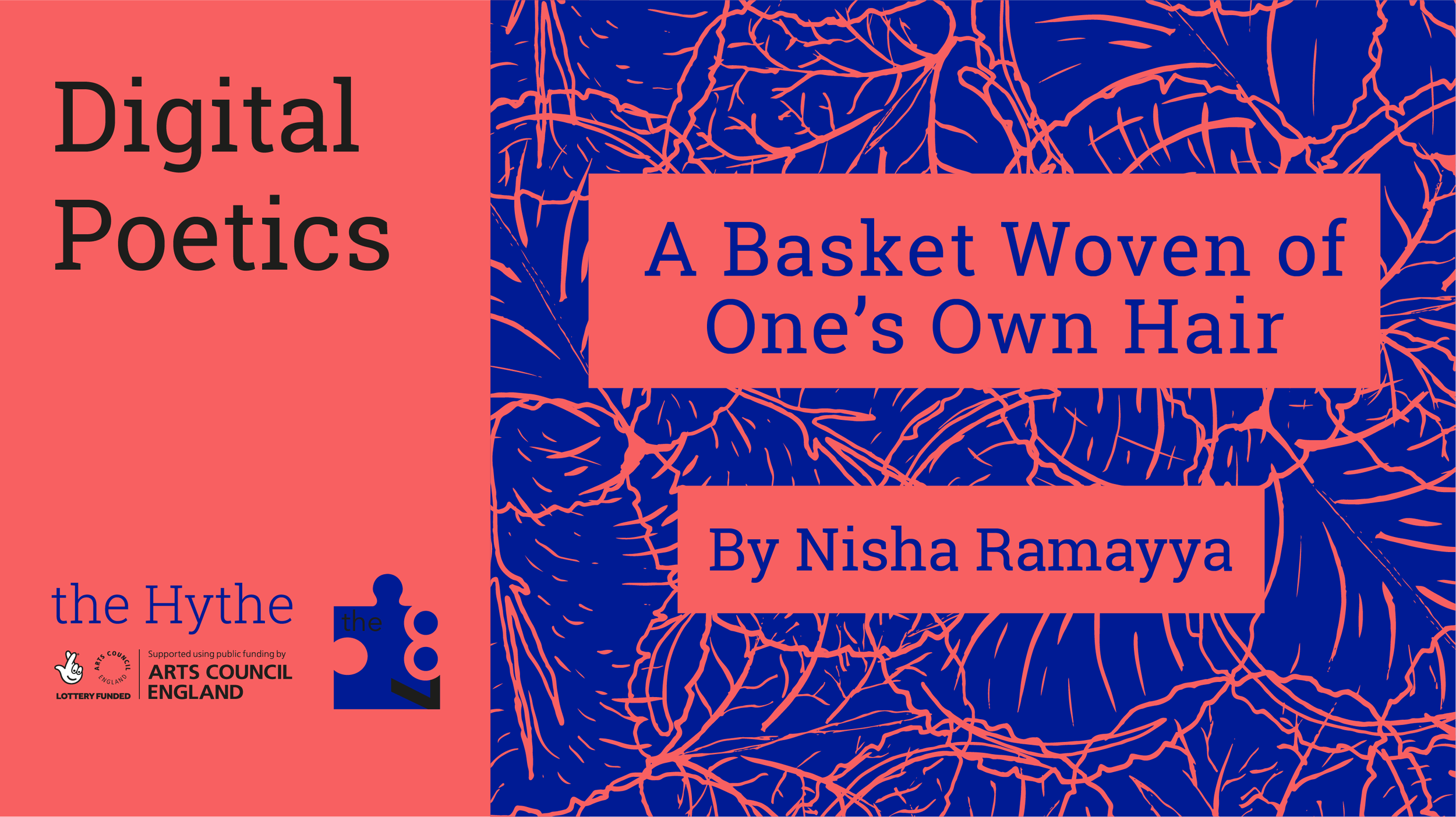Digital Poetics #16 A Basket Woven of One’s Own Hair: Nisha Ramayya
What is the purpose of musical (as a segment of a general aesthetic) categorisation? Why does the categorisation of music function so similarly to the modes of categorisation used to racially determine the nation? Why does the free movement of music across the border of genre raise such violent consternation? In what sense is listening, and its resulting construction of an audience, an activity that can easily lend itself to a xenophobic disposition?
– Dhanveer Singh Brar
We tried to exfoliate the sounds of their realities, washing them with pumice stones until they were of a single aperture stretched and arranged into the layers of the play. Sound was all that survived of sound. Such definitions, like the shell of the nautilus, were scenes in our crystallising minds.
– Patrick Farmer
…intricately woven nets which when laboriously unknotted are seen to contain one blue pebble, an imperturbably functioning chronometer telling the time on another world and a mouse’s skull…
– Ursula K. Le Guin
Hello? Is someone there?
– Dr Ellery Vas
The nameless dread attending onomatopoeia is… the acousmatic monolithic that displaces reflective space. It’s like a bathtub in a bathtub in a bathtub to infinity, without anyone to find the lyric-it and sing about it. Onomatopoeia is the containerisation of the past in the present (in the future); the valorisation of perfect rhyme at the expense of grain; the ratification of sameness in service of representation. Onomatopoeia may pose a grave threat to diasporic experimentalism for these reasons and more. Kukūnana [poet gargles on stage]!!! At a dinner party in the mirror universe, we’re all played by fungi – beautiful, submarine, networked fungi – and a xenobiologist descends to catalogue us, channels our spore clouds, and eventually helps us converse. Our words and images tend to oscillate irregularly, which makes us easy to ignore; what seems like blurriness from a distance is methodically bound up close.
L argues: ‘The point at which sound reminds us of our corporeality is often also the point at which sound is described as becoming noise.’
you put your left vom in /// your left vom out /// vom in vom out /// you shake it all about
Difference as the radiant crown of body odour that can be perceived from a distance – a hurtful but inconsequential example. Here’s a sequence that spreads, an incrementally disclosed map of exclusions: bus ride, dance, tribunal. His nose crinkled condemnatory. The virulent splaying of hokey cokey. White judge smiling at white prof-manager smiling at the employer’s white legal team; their neighbourly triangulation of racist deniability. Ooof.
D describes a correspondence between ‘the racial policing of the experimental’ and the ‘racial policing of the nation’, asserting that: ‘The violent assembly of home and belonging is as much an aesthetic endeavour as it is a policy issue.’
that’s what it’s all about /// that’s what it’s all about /// that’s what it’s all about
When most of our chats take place under water, not in the stars as I’d thought, we go buḍabuḍa-buḍabuḍa, dispensing bubbles to kiss. I say that I’ve let the ill winds in, that they were already swirling inside me; you suggest an alternative, identifying flow as a stabilising force. Sometimes observation is the healthiest form of participation in the sex dream, its outside balancing the psychic books. Poetry as the stuff that’s cropped out of postcards; in the background, a congregation of wind turbines, dumped fridges forming a breakwater in front. Is the problem of categorisation a problem with the production and utilisation of categories or with the process of recognising and responding to the problem itself? Because, in my favourite poetry, the object isn’t more beautiful wrested from its source, and you don’t get to cup it tenderly before crushing it. Because, if thinking is fucking, the leg of the stool is kicked out!
P writes, in a letter to an unaddressed addressee: ‘We’re far out to sea. The shell of the paper nautilus enables a state of buoyancy wherein the force of an object submerged in a fluid is equal to the weight of the fluid it has displaced. The liberty of internal renewal.’
you put your right vom in /// your right vom out /// vom in vom out /// you shake it all about
One might feel foreign to oneself, as if hovering before oneself and trying to lipread. Lyric-you and lyric-I look over there to see who’s beaming in, leaving space to defend ourselves against them, if necessary; holding space to show that we can handle the unknown. That kind of poetry, like gigantic ears flapping against the window at night. Like living next door to the internet, once in a blue moon dropping by in your blanket of tongues, and licking reboot.
A and T ask: ‘What is your current relationship to change?’ [What does it mean to think of change as your god, and why does this question elicit resistance?]
that’s what it’s all about /// that’s what it’s all about /// that’s what it’s all about
*
This publication is in Copyright. Nisha Ramayya, 2020.
The moral right of the author has been asserted. However, the Hythe is an open-access journal and we welcome the use of all materials on it for educational and creative workshop purposes.
*
Nisha Ramayya grew up in Glasgow and is currently based in London. Her collection States of the Body Produced by Love (2019) is published by Ignota Books. Recent publications include ‘Following Ten Million Dinner Parties’ for Flatness; a ‘Memo on Multiplicity’ for Frieze; ‘Notes on a Means without End’ in Poetry Review. In Spring 2020, Ramayya was Poet in Residence for the group exhibition Many voices, all of them loved at John Hansard Gallery, Southampton; ‘A Basket Woven of One’s Own Hair’ is part of the series ‘Now Let’s Take a Listening Walk’, initiated during this residency.

